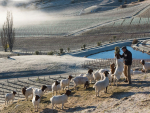While the wines of 2012 promise to be outstanding, growers and wineries have faced a considerable drop in yields. Early New Zealand Winegrowers estimates put the vintage at approximately 300,000 tonnes, down from last year’s high of 328,000.
But those estimates were pre harvest – the reality is likely to be far less. Which in terms of the woes of recent years, is good news long term.
Unfortunately it isn’t good news for growers and wineries in the short term, given the financial situation many are in.
There is another issue that will raise itself now vintage is over. What do growers do in terms of setting up the vines for vintage 2013? With a very cool December 2011 in many parts of the country, initiation this coming December is likely to be much lower than in previous years. Given many growers have pruned to three and in some cases two canes in an effort to manage yields, what should they do this coming year? Should they retain three canes, or should they go back to four? Research shows that even if you increase the cane numbers by 25 per cent, it won’t necessarily equate to a 25 per cent increase in yield. Should you increase bud numbers, or is the likelihood of near on perfect conditions at flowering likely to see your yields rise to beyond suitable levels?
Yield estimates should begin now, with wineries and growers working together to determine just what the
best course of action is, prior to the
pruners moving into the vineyard.
All scenarios have to be considered. What will happen if there is a repeat of the poor flowering conditions of this vintage? What is the likelihood of a perfect flowering – and what is the cost going to be if there is too much fruit on the vines, come January 2013.
New Zealand Winegrowers will be sending members an information sheet that will help you to make those all important decisions.
On another note, July 1 is looming and for wineries that means another increase in Excise Tax. After last year, any further rise is bordering on destructive. With the Alcohol Law Reform Bill still making its way through parliament, and the impact that may have on cellar doors around the country, the increase of excise, could well be the last straw. If you think I protest too much, consider these figures provided to me by Neil Ibbotson of Saint Clair Wines in Marlborough.
Approximately $2.00 per bottle, on all local wine sold in New Zealand goes to the Government.
This equates approximately to $170 million paid to the Government per year from the New Zealand wine industry by way of excise tax.
In Marlborough alone that is close to $127 million.
Growers (in Marlborough) receive approximately $1400 per tonne for their grapes, whilst the Government takes the equivalent of approximately $2000 per tonne.
How ludicrous is that? It’s time for all industry members to start lobbying even harder for a change in attitude. Maybe, someone, somewhere will start to listen. ν












